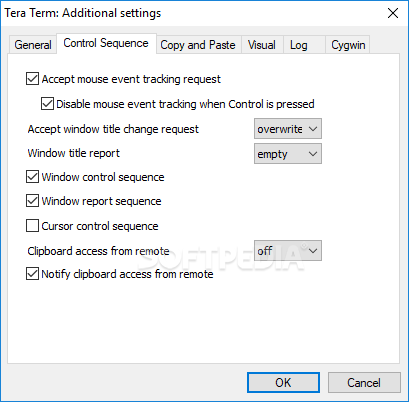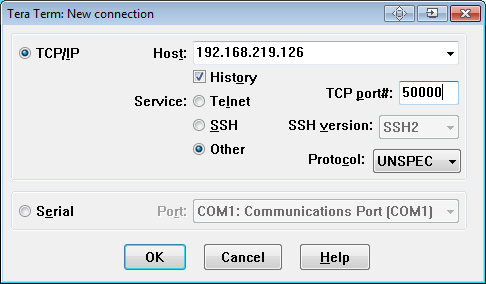
For example, an SC-ICPMS running only masses 238, 207, andĢ06 (232, 208, and 204 are also typically measured) at equal dwell times Samples with low levels of Pb (i.e., young and/or low common Pb).įurthermore, its equivalent sensitivity is even higher because it measures all massesĪt the same time. An MC-ICPMS, on the other hand, is 2–3 times more sensitive Making 204- or 208-based common-Pb corrections (e.g., Parrish etĪl., 2018). Multiple detectors, yielding simpler data reduction and the possibility for Only one SEM on SC-ICPMS instruments, there is no need to cross-calibrate The SC and MC instruments have distinct advantages. SC-ICPMS instruments measure isotope count rates sequentially with a single On the low-mass side of the array to concurrently measure Pb isotopes The high-mass side of the detector array to measure 238U andĢ32Th and either Faraday cups or secondary electron multipliers (SEMs)
TERA TERM VT FREEWARE SERIES
Traditionally, an MC-ICPMS uses a series of Faraday detectors on Sector-field instrument), or multi-collector (MC-ICPMS) sector-field Usually contains low levels of Th (Parrish et al., 2018).įor typical LA-ICPMS analyses, a 193 nm excimer laser is employed inĬonjunction with either a single-collector (SC-ICPMS either a quadrupole or Titanite and apatite (e.g., Chew et al., 2014 Spencer et al., 2013), butĬalcite also lends itself to a 208Pb-based correction, given that it These isochron ages are calculated with ease on a Tera–Wasserburgĭiagram similar to other common-Pb-bearing mineral chronometers like To U and Pb, using larger datasets to better constrain both the initialĢ07Pb ∕ 206Pb compositions and the common Pb-corrected concordiaĪges. LA-ICPMS also has the advantage of sampling smaller volumes of material itĬan thus take advantage of the heterogenous nature of calcite with respect Sample preparation is minimal, several samples can be analyzed in a day, andĭozens of labs worldwide have the capability to perform such analyses. Geochronology in a relatively short period of time and for little cost Least, screen a large number of samples and choose those suitable for

Reduced, such that hundreds of geoanalytical facilities can, at the very LA-ICPMS, however, sample throughput and analytical costs have been greatly Those with potentially low U contents, were ignored. Produce reliable ratios samples with a low likelihood of success, that is, (e.g., Richards et al., 1998), because the methodĮmployed – thermal ionization mass spectrometry (TIMS) – required weeks to Likely to contain high concentrations of U, such as speleothems Paleoclimate, sedimentation, and diagenesis (e.g., Mangenot et al., 2018 Potential for solving numerous geochronologic problems from the timing ofįaulting (e.g., Roberts and Walker, 2016 Nuriel et al., 2017 GoodfellowĮt al., 2017) and the age of ore deposits (Burisch et al., 2017) to Spectrometry (LA-ICPMS) is a relatively new technique with untapped Minimum of ∼ 10 ppb U is needed at a spot size of 100 µm and rep rate of 10 Hz absolute uncertainty scales roughly with UĬalcite U–Pb geochronology by laser-ablation inductively coupled plasma mass AsĪn example, for samples necessitating a < 1 Ma uncertainty, a LA-ICPMS – a model is created and discussed these models are meant to serveĪs a guide to evaluate potential candidate materials for geochronology.

Limits – i.e., the minimum U, Pb, and U ∕ Pb ratios that can be measured by Age precision for samples run in this mode are limited byĢ07Pb counts and the maximum U ∕ Pb c. That measurement of 238U by Daly is advantageous at count rates < 30 000 this includes samples low in U or those necessitating Limit and high dynamic range of the Nu P3D for calcite U–Pb geochronology andĬompares it with traditional methods. A new method, described herein, utilizes the low detection The Nu P3D MC-ICPMS employs a new detector array to measure all isotopes of interest onĭaly detectors. Traditional geochronometers (e.g., zircon) by MC-ICPMS has been limited byĭetection of the daughter isotope, U–Pb dating of calcite can be limited byĭetection of the parent isotope if measured on a Faraday detector. Multiple collectors (MCs), is advantageous. Of U and Pb, measurement by more sensitive instruments, such as those with Potential to solve a vast array of geologic problems. Inductively coupled plasma mass spectrometry (LA-ICPMS) is an emerging field with U–Pb geochronology of calcite by laser-ablation


 0 kommentar(er)
0 kommentar(er)
